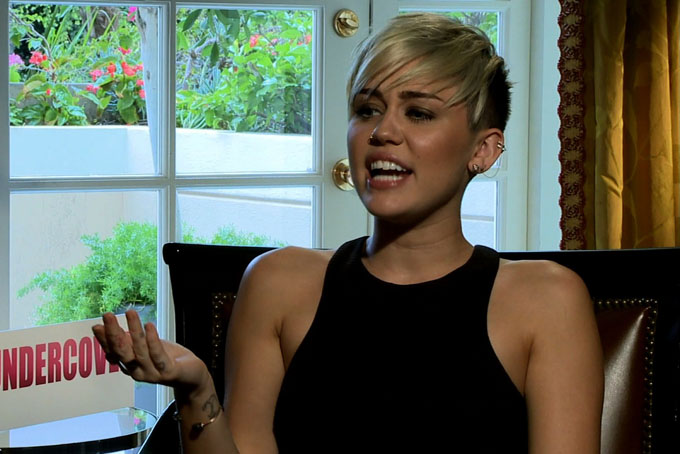
(CNN) — This week, Time magazine named Miley Cyrus a finalist for Person of the Year, the annual award bestowed on the person editors think has “most affected the news and our lives, for good or ill, and embodied what was important about the year.” A true testament to the global influence of twerking, she was the only nominee from the entertainment industry.
Her co-nominees included Syrian President Bashar al-Assad, President Obama, Pope Francis, and gay rights activist Edith Windsor.
The pope was the winner, but one thing’s for certain: Miley Cyrus makes an impact. Regardless of whether you care about her latest performance or haircut or provocative, eyebrow-raising declaration to the press, it’s likely you’ll have heard about it. In part, that’s owing to her affinity for ever-media-friendly shock, delivered in the form of a raunchy, nudity-filled music video; a raunchy, nudity-filled photo shoot with photographer Terry Richardson; and a raunchy awards show performance that likely would have contained some nudity had it been allowed. It did, however, contain a foam finger and a latex bodysuit. And a tongue that was a performer of its own.
Shocking behavior isn’t uncommon in the entertainment industry, and especially in music. Shock, like sex, sells. But it’s quite possible Cyrus isn’t selling just shock, and albums. She’s also selling drugs.
Earlier this year, Miley ended months of speculation that one of her song lyrics referred to “Molly,” the nickname for psychedelic drug MDMA, or a form of Ecstasy. When she was asked if she was referring to her own name or the drug Molly in the song “We Can’t Stop,” she told The Daily Mail, “If you’re aged 10, it’s ‘Miley.’ If you know what I’m talking about, then you know.”
In September, she offered a second endorsement, telling Rolling Stone that marijuana and Molly are “happy drugs — social drugs. They make you want to be with friends.”
What effect might the former Disney star’s drug advocacy have on the legions of tween and teen fans who follow her every move?
A 2008 study looking at the influence of technology, media and pop culture on criminal behavior concluded that while young people are influenced by pop culture, and more so than adults, it was difficult to empirically study the cause and effect of pop culture on their behavior.
And certainly, the glorification of vice in music is not at the hands of Miley Cyrus alone: A 2008 study out of the University of Pittsburgh School of Medicine and published in the Archives of Pediatrics and Adolescent Medicine found that 33% of the top 300 songs on the top of the Billboard charts portrayed drug or alcohol use — an increasing number of them pop songs — which means that kids receive about 35 references to substance abuse for every hour of music they listen to.
That said, what we do know: Exposure to excessive violence in video games can increase aggressive attitudes, behaviors and values, particularly in children. And adolescent exposure to music, a powerful social force often linked to identity, memories and mood, is much more frequent than it is to any other form of pop culture.
According to the Pittsburgh School of Medicine study, most teens listen to an average of 16 hours each week of music, compared with about six hours each week for movies. Perhaps more than any other entertainment medium, the study authors wrote, “music is well known to connect deeply with adolescents and to influence identity development.”
And so it’s hard not to argue that Molly is likely reaping the benefits. The numbers are there: A 2010 National Survey on Drug Use and Health found that 12.4% of Americans between 18 and 25 had experimented with MDMA, while a report released last week by the U.S. Substance Abuse and Mental Health Services Administration stated that emergency room visits related to MDMA increased 128% between 2005 and 2011 among people younger than 21.
“Everyone wants to try it,” a recent Teen Vogue article quoted a 19-year-old named Samantha as saying, and indeed many are: In recent months, there were multiple suspected MDMA-related deaths and hospitalizations reported along the East Coast, and in October, MDMA was linked to 10 Chicago-area deaths.
Music might not make kids do drugs. But it’s naïve to think that music isn’t having an impact on kids’ behavior and perception — and that all this attention Cyrus is getting isn’t teaching them something about what it takes to get noticed. (Meanwhile, all the attention MDMA is getting will, naturally, serve to pique curiosity.)
Cyrus is an adult. She can sing about and ingest whatever she wants — but naming her a Person of the Year? Well, it’s a tough pill to swallow. Unless, of course, you’re a drug named Molly.
Editor’s note: Peggy Drexler is the author of “Our Fathers, Ourselves: Daughters, Fathers, and the Changing American Family” and “Raising Boys Without Men.” She is an assistant professor of psychology at Weill Cornell Medical College of Cornell University and a former gender scholar at Stanford University. Join her on Facebook and follow her on Twitter @drpeggydrexler.